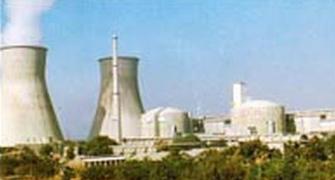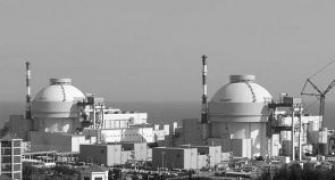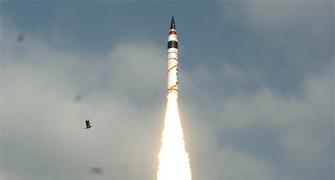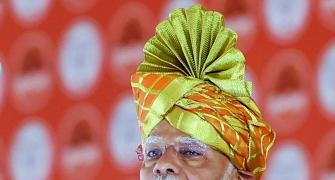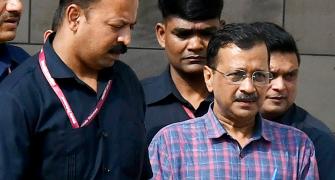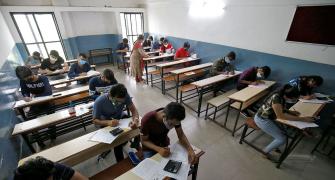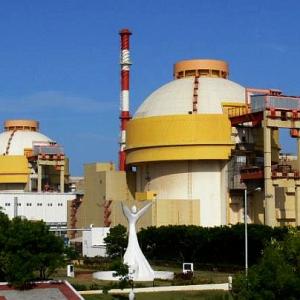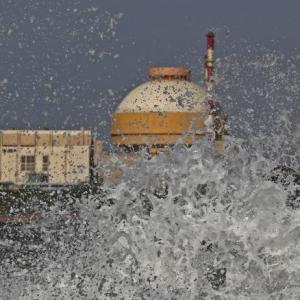'At a time when the entire India-US relationship needs to be defined by President Trump and Prime Minister Modi, a fresh look at the liability issue has become urgent,' says Ambassador T P Sreenivasan, former Governor for India at the IAEA.
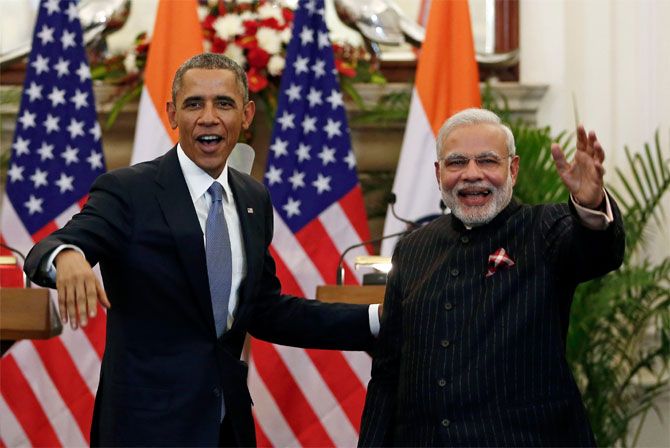
Long before the enactment of the Nuclear Liability Law by the Indian Parliament, the US had, under the Obama administration, developed a thought that India-US nuclear trade might not be possible or desirable.
After speaking to a senior White House official, I had said in my Rediff column dated August 21, 2009: '(But) the latest indication from Washington is that the US may not be interested in supplying nuclear material and reactors to India under the new dispensation.'
'This is emerging as a matter of policy as well as a practical measure. President Obama does not want to stand in the way of the implementation of the 123 Agreement, but he is sensitive to the criticism that he is willing to dilute his commitment to non-proliferation for the sake of commercial advantages.'
The feeling was that defence purchases will make up for the revenue loss on account of not having nuclear trade with India.
As of today, the US has not supplied even a kilogram of nuclear material to India, not to speak of supply of two to six reactors on which agreement was reached in principle on the basis of a commitment in writing given by India.
The blame is placed on the Nuclear Liability Law enacted in 2010 under which the Government of India has the option to recourse to the law to claim compensation from the suppliers in the event of a nuclear disaster.
This was not in keeping with international law, under which only the operator was liable.
It was obvious at that time itself that the proponents of the Liability Law had accomplished through the law what they could not do at the time of the vote on the 123 Agreement, as one of the objectives of opposing the Agreement was to deny the US a nuclear market in India. But Parliament was influenced by the tears shed for the victims of the Bhopal tragedy.
When the likely consequences were pointed out by bodies like the National Security Advisory Board, the government stated rather facetiously that any problems would be dealt with through the regulations to be framed later.
The US government and the companies concerned had made it clear at the time that as long as the law existed, no nuclear transfer would be possible.
The lawyers on both sides were quite optimistic that they would be able to find a way out through a legal fix, but many rounds of negotiations produced no results.
India signed the Vienna International Convention on Supplementary Compensation for Nuclear Liability as a way to resolve the issue, but that too was of no avail. No details of the negotiations were available and there was no white smoke either.
After Prime Minister Narendra Modi's maiden visit to the United States, President Barack Obama announced that the US and India had reached 'a breakthrough understanding' on the Liability Law, which would enable the companies on both sides to commence negotiations.
This was hailed by both sides as the single most important outcome of the visit and PM Modi was praised for his refreshing ability to cut across the hesitations of history to move forward.
But it was soon clarified that the law would not be changed and that the business negotiations should lead to some understanding that liability for the supplier was not mandatory and that it was only an enabling resolution.
It was also clarified that the amount of liability would be capped and paid for from an insurance pool.
In other words, there was no breakthrough and the legal parleys continued without any business deal.
The then foreign secretary Sujatha Singh, who said 'it is a done deal' mysteriously lost her job within a few days.
The issue came to surface again when it was announced after another Modi visit to the US in June 2016 that six Westinghouse reactors would be built in Andhra Pradesh and that preparatory work would begin shortly.
Techno-commercial discussions have been in place with Toshiba-backed Westinghouse and simultaneously there have been protests by local residents.
It was also announced that India would go for bulk purchases of reactors from the US and France.
The site for the American reactors had been shifted from Mithi Virdi in Gujarat to Kovvada in Andhra Pradesh when GE-Hitachi was supposed to set up the reactors.
But contrary to the understanding of the US state department, GE said that the liability issue was not addressed adequately by India signing the Convention on Compensation and that the suggested insurance pool would not suffice.
Westinghouse and Toshiba, which stepped in, appeared to be willing to work on the basis of the insurance pool, but the Nuclear Intelligence Review reported in early January 2017 that Westinghouse had become nearly bankrupt and an 'albatross' around Toshiba's neck and that it would not be able to fulfill its commitments to India.
More recently, Westinghouse and Toshiba announced out of the blue that the differences with India on the liability issue were irreconcilable and that 'legislation on nuclear damage is necessary to promote projects in India.'
But the real reason, it is alleged, is that it reflects Toshiba's struggle for survival.
The nuclear trade with the US is in limbo once again even if the US was sincere in seeking to resolve the liability issue.
What is at stake is also India's plans to jump from 5.78 gigawatts of nuclear power today to 63 gigawatts by 2032.
The heart of the matter may well be the decision taken by President Obama in 2009 that no nuclear material should be supplied to India, though it appeared that a genuine effort was being made at the technical levels to resolve the liability imbroglio.
A statement made by a senior Indian nuclear scientist in Thiruvananthapuram last year that the US was using the liability issue as a smokescreen not to initiate nuclear trade with India rings true now.
At a time when the entire India-US relationship needs to be defined by President Donald Trump and Prime Minister Modi, a fresh look at the liability issue has also become urgent.
India had decided to go ahead with 'business as usual' even after the prospects of nuclear power had diminished, following the Fukushima accident.
India's assessment of Fukushima was that it was not serious enough to warrant any rethinking on nuclear power. Some recent reports show that the environmental contamination inside Fukushima was more serious than anticipated.
Asahi Shimbun, the Japanese newspaper, reported on February 19, 2017 that the radiation level in the damaged reactor was 650 sieverts per hour, deadly enough to kill a human being in less than a minute. The earlier estimate was only 530 sieverts per hour.
Another review of the acquisition plan may become inevitable in the new circumstances. A re-examination of the composition of India's energy mix itself may become necessary since, except for Kudankulam, no new foreign reactor is in place since the signing of the nuclear deal in 2008.
MUST READ features on India's nuclear programme in the RELATED LINKS below.

